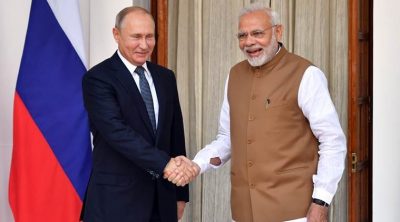The US Is Now India’s Number One Trading Partner and Ally, Jeopardizing Russia’s Pipeline Plans

Russia’s “Return to South Asia” was supposed to see it build the Iran-Pakistan-India (IPI) gas pipeline as a means of promoting peaceful multipolar regional integration, but the US is about to jeopardize this plan after it was disclosed just days before Pompeo’s upcoming visit to India that America has suddenly become the South Asian state’s top trading partner.
Regional integration processes are one of the defining features of the emerging Multipolar World Order, and in spite of India sabotaging the South Asian Association for Regional Cooperation (SAARC), there was recently hope that Russia could play a pivotal “balancing” role in reviving this organization through the energy component of its “Return to South Asia“. The Eurasian Great Power envisaged building the long-discussed Iran-Pakistan-India (IPI) gas pipeline after having already clinched memorandums of understanding (MOUs) with the first two-mentioned states for this $10 billion regional connectivity initiative , with negotiations currently ongoing with the Indian side to ensure their support as well. Therein lays the weak link in this vision, however, since India is unlikely to go along with Russia’s plans, or if it does unexpectedly end up signing a MOU in this respect, it would only be doing so to buy time and save face before eventually creating a pretext to pull out of the project.
It’s not that India doesn’t need reliable access to gas — it does, and urgently — but that the intense pressure being brought upon it by its new American military-strategic ally might make it impossible for it to seal a deal with Russia, let alone one that would see Moscow guaranteeing the export of Iranian resources to what is predicted to be the world’s most populous country before the end of the next decade. The US has imposed unilateral sanctions against both of those multipolar Great Powers, and India is already complying with the ones against the Islamic Republic. It’s very likely that it will soon do the same when it comes to purchasing Russia’s S-400s, especially if Pompeo’s upcoming trip sees his promised “surprise” being an official offer to place India on its International Traffic in Arms Regulations (ITAR) list as a reward for replacing those systems with THAADs, Patriots, and possibly even F-35s instead. Russia can’t offer India the treasure trove of high-tech military equipment that the US could through that arrangement, so it’s a no-brainer which of the two New Delhi will probably go with.
Perhaps the most important factor, however, is that it was just disclosed days before the Secretary of State’s trip that the US is now India’s top trading partner, which Sputnik reports is due to the increase of American energy exports after New Delhi ditched Tehran. Part of the reason why the US wants to replace Russia as India’s preferred military partner just like it’s already succeeded in doing with Iran as regards its target’s energy needs is to more deeply entrench its comprehensive economic influence over the South Asian state so that it can more effectively weaponize the market access on which New Delhi is increasingly growing dependent, leveraging sanctions and tariff threats in order to completely control its new “Lead From Behind” “Indo-Pacific” proxy prior to clinching a forthcoming free trade deal with it to institutionalize this relationship. Seeing as how the US already got India to stop purchasing Iranian energy and might very well get it do to the same when it comes to Russia’s S-400s, it’s extremely unlikely that it would just sit back and accept its new vassal signing a regional pipeline deal with both Great Powers that are under its current international sanctions regime.
The scenario therefore arises that Russia might not be able to rely on India as the largest and final customer of its prospective IPI pipeline, thus compelling it to plan for the possibility of having this project either fully servicing the global pivot state of Pakistan or extending across the country to China via the energy corridor of E-CPEC+. Both solutions are economically and strategically viable, with the latter one understandably being much more expensive but ultimately resulting in the strengthening of the new Multipolar Trilateral between Russia, Pakistan, and China in the event that it’s ever completed. As such, Russia shouldn’t be too concerned about India possibly pulling out of the project or insincerely committing to it for the time being in order to buy time and save face before fully pivoting towards the US since the proverbial “silver lining” is that Moscow’s “Return to South Asia” will inevitably adapt to these changed circumstances and nevertheless still contribute to restoring “balance” to regional affairs in one way or another.
*
Note to readers: please click the share buttons above or below. Forward this article to your email lists. Crosspost on your blog site, internet forums. etc.
This article was originally published on Eurasia Future.
Andrew Korybko is an American Moscow-based political analyst specializing in the relationship between the US strategy in Afro-Eurasia, China’s One Belt One Road global vision of New Silk Road connectivity, and Hybrid Warfare. He is a frequent contributor to Global Research.

